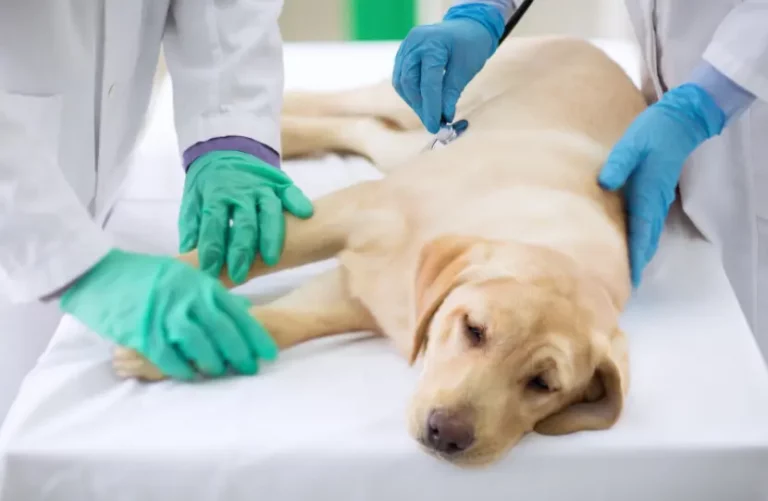Symptoms And Treatment Of Dog Hip Dysplasia
Hip dysplasia affects over 20 million dogs in the United States, making it one of the most prevalent musculoskeletal diseases in canines. While larger breeds like Golden Retrievers and German Shepherds are at a 10%-20% higher risk, smaller species like French Bulldogs and Pugs are not immune. Over 50% of dogs affected weigh under 40 lbs.
As a dog owner, it’s crucial to understand the causes, warning signs, and prevention tactics for this painful condition. Genetics account for 35% of cases, but environmental factors like diet, exercise, and weight play a role too.
Puppies should be fed nutritious food with at least 20% protein and 5% fat for healthy bone development. Moderate exercise, like 30-60 min walks daily, can strengthen musculoskeletal health. Obesity stresses hip joints, so maintaining a target weight is vital.
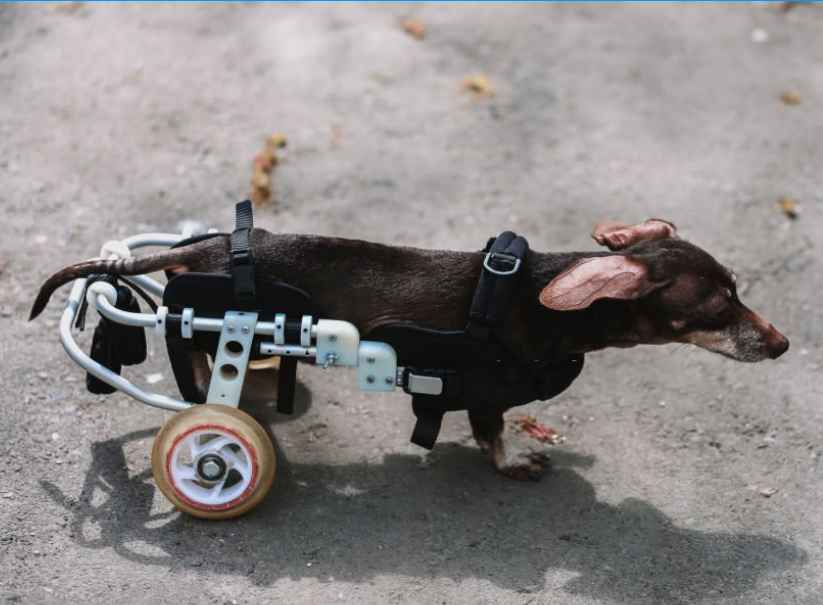
Catching hip dysplasia early, when dogs are 4-12 months old, leads to better outcomes. Look for symptoms like limping, difficulty standing up, losing thigh muscle mass, and decreased activity levels. Early screening X-rays your vet performs can identify laxity in hip joints before osteoarthritis sets in. Being an informed pet parent allows you to take proactive steps for your dog’s comfort and mobility.
Table of Contents
- What is Hip Dysplasia in dogs?
- Reason of hip dysplasia in dogs
- When do dogs develop Hip Dysplasia?
- Do environmental factors play a role in Hip Dysplasia (CHD)?
- Signs and symptoms of Hip Dysplasia in dogs
- How To Diagnose Hip Dysplasia?
- Diagnosed and Treatment Process of Dog Hip Dysplasia
- Decrease the risk of Hip Dysplasia
- Can dog hip dysplasia be cured?
- Conclusion
What is Hip Dysplasia in dogs?
The definition of Hip Dysplasia,
Hip dysplasia in dogs is a skeletal deformity that affects the hip joints. It is a developmental condition that begins when dogs are puppies and continues as they grow.
Here are some critical facts about canine hip dysplasia.
- Hip dysplasia is one of the most common orthopedic diseases in dogs. It affects over 20 million dogs in the United States.
- It occurs when the hip socket does not surround the ball portion of the upper thigh bone. This leads to an unstable joint.
- Larger breed dogs like Labrador Retrievers, German Shepherds, and Rottweilers are most susceptible, but can also occur in smaller breeds.
- Hip dysplasia is often confused with arthritis since they share similar symptoms of limping and discomfort. However, arthritis occurs from wear and tear in older dogs, while dysplasia is a developmental deformity in young, growing dogs.
- As dogs with hip dysplasia mature, the instability in the joint can lead to the early onset of degenerative joint disease/osteoarthritis. This results in chronic pain and loss of mobility.
- Diagnosis is made through physical examination and X-rays. Treatments include medications, lifestyle modifications, surgery, and sometimes total hip replacement.
The key is to catch hip dysplasia early before secondary arthritis sets in. Responsible breeding, proper nutrition, and preventing obesity can help reduce risk.
Reason of hip dysplasia in dogs
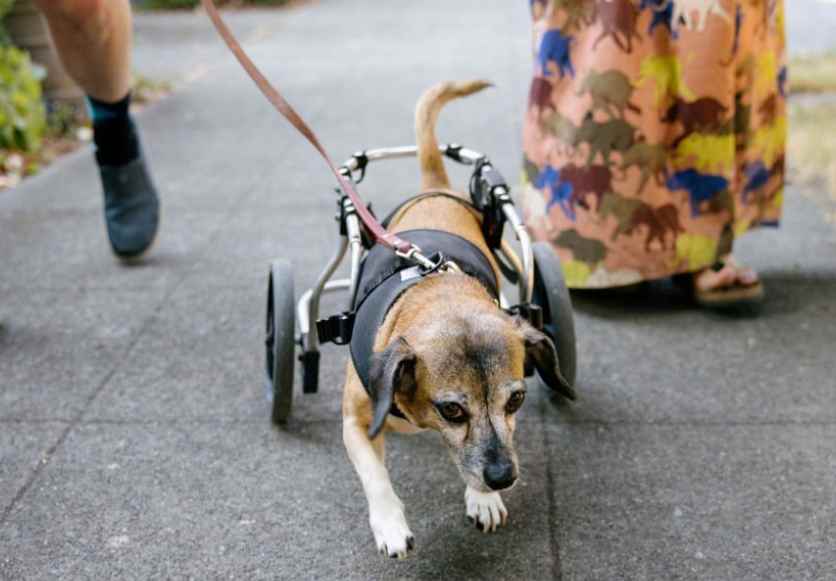
There are two primary causes of hip dysplasia in dogs.
- Genetics
Hip dysplasia is primarily an inherited condition. Certain breeds like German Shepherds, Labrador Retrievers, and Saint Bernards are genetically predisposed. An estimated 35% of cases are due to genes that lead to improper hip joint development.
- Diet
Rapid growth from a high-calorie diet in large and giant breed puppies is a risk factor. Excess weight stresses joints. Puppies should be fed a complete and balanced diet with 20%-25% protein and 5%-8% fat for a controlled growth rate.
The hip joint has two main parts – the acetabulum (hip socket) and the head of the femur (thigh bone). In hip dysplasia, these two parts do not fit snugly together.
This leads to,
- Joint laxity – unstable, loose hip joint.
- Loss of normal joint function.
- Grinding of bone surfaces.
- Early onset arthritis (degenerative joint disease).
Over time, the constant friction erodes cartilage, causes microfractures in the bone, and results in scar tissue formation. The joint instability progresses until the dog experiences “chronic pain, stiffness, and mobility issues”.
Early diagnosis and prevention of obesity are key to mitigating the progression of hip dysplasia.
When do dogs develop Hip Dysplasia?
Dogs can develop hip dysplasia at different ages, though it often starts when they are puppies. Puppies can show signs of hip dysplasia as early as 3-4 months old. This is a critical developmental period. Large and giant breeds are most susceptible due to their rapid growth rate. Species like Mastiffs, Newfoundlands, and St. Bernards are at high risk.
On average, most dogs begin to show symptoms between 4-12 months of age as they near maturity. However, some dogs may not show noticeable signs until 1-2 years old. It can develop in dogs of any breed, sex, or neuter status. Due to genetic factors, purebreds have a higher incidence rate, around 10%-20%.
Smaller breeds like French Bulldogs may develop hip dysplasia later in life, between 4-6 years old.
The critical point is that hip dysplasia originates early in life as the dog’s hip joints are forming. Though symptoms may not arise until later adulthood, early screening and prevention in puppyhood is essential for high-risk breeds. Responsible breeding and nutrition can help reduce the chances of this painful, mobility-limiting condition.
Is Canine Hip Dysplasia Genetic Disease?
Yes, canine hip dysplasia has a strong genetic component. Hip dysplasia is one of the most prevalent inherited orthopedic diseases in dogs. Genetics accounts for approximately 35% of cases. Cornell University College of Veterinary Medicine, has Studied genetic environmental risk factors and, according to studies, developed breeding recommendations to lower disease prevalence.
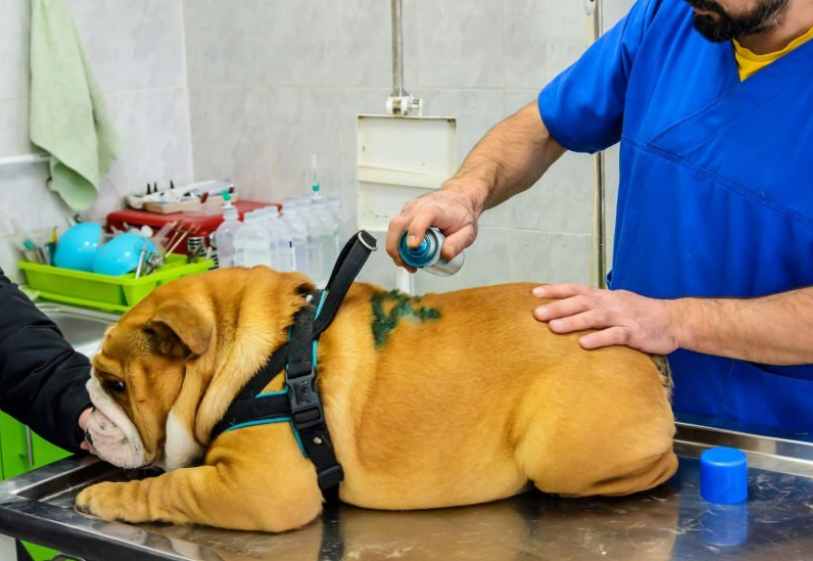
Certain breeds, like Labrador Retrievers, German Shepherds, and Golden Retrievers, are genetically predisposed, with 10%-20% incidence rates. Over 70% of purebred dogs may develop hip dysplasia due to closed gene pools and inbreeding practices in some lines.
Dogs that overgrow due to their genetics are more prone to joint malformations. This includes large and giant breeds. Genes influence the hormones that regulate bone and muscle development in the hip joint. Improper development leads to a loose, unstable fit between the femur and hip socket.
Dogs weighing over 50 lbs (22 kg) have a higher risk since heavier body weight stresses the hip joints. Environmental factors like diet, exercise, and injury make up the remaining 65% of causes.
Responsible breeders screen parent dogs and focus on breeding those with healthy hips to reduce the prevalence of future litters. There are also screening tests to identify affected dogs.
Hip dysplasia is common among many giant breeds of purebred dogs. The species most susceptible to this inherited orthopedic disease include.
- German Shepherds
- Rottweilers
- Labrador Retrievers
- Golden Retrievers
- Saint Bernards
- Great Danes
- Mastiffs
- Newfoundlands
- Old English Sheepdogs
- Bulldogs
- Basset Hounds
- Bloodhounds
- Pugs
- Chow Chows
- Otterhounds
These breeds have an incidence rate of 10%-20%.
Mixed breeds are also at risk, especially if parent breeds are prone to hip dysplasia.
Some examples of high-risk mix breeds are,
- Boxer-Labrador mixes (Boxadors)
- German Shepherd-Rottweiler mixes (Shotties)
- Golden Retriever crosses
- Labrador mixes
These larger breeds are predisposed due to genetic factors that lead to improper hip joint formation during development. Responsible breeding and screening are essential to reduce this disease’s prevalence.
Do environmental factors play a role in Hip Dysplasia (CHD)?
Yes, environmental factors can also contribute to developing hip dysplasia in dogs.
- Diet
Excessive calorie intake and rapid weight gain, especially in large-breed puppies, are major risk factors. It places increased force on the hip joints during development. Puppies should be fed an age-appropriate diet with controlled calories and nutrients.
- Nutrition
Lack of proper vitamins and minerals like calcium, phosphorus, and vitamin D impacts skeletal growth. Puppies need a complete and balanced diet for healthy bone formation.
- Exercise
Too little or too much exercise can cause issues. Moderate activity like 30-60 minute daily walks strengthens muscles and connective tissue around the joint. If puppies are under 18 months, high-impact exercise should not be allowed.
- Injury
Any trauma to the pelvis and hips at a young age increases susceptibility to joint deformities. Preventing slips, falls, and excess activity is key.
- Obesity
Extra body weight stresses the hip joints. Over 50% of dysplastic dogs are overweight. Maintaining an ideal weight is essential.
While genetics play a bigger role, focusing on proper nutrition, controlled exercise, and injury prevention in the first year of life reduces the risk of hip dysplasia. Environmental factors are estimated to make up 65% of causes.
Signs and symptoms of Hip Dysplasia in dogs
Hip dysplasia is a progressive disease, and 75% of dogs may not show symptoms until later in life. Early screening and diagnosis provide the best opportunity to slow progression. Owners should monitor for any gait abnormalities and have annual vet exams. Managing weight and exercise is key.
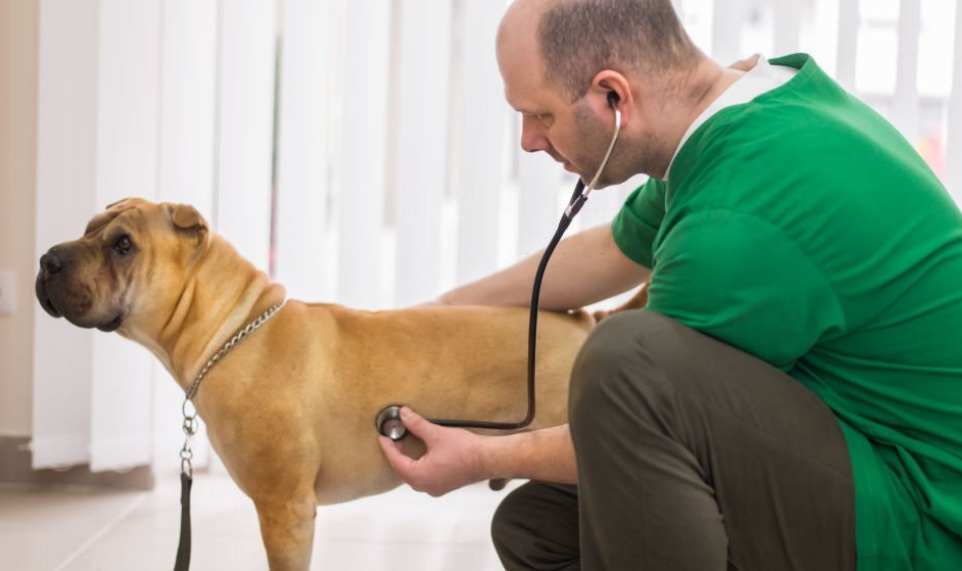
Some key symptoms may arise when dogs are juveniles under 18 months old.
- Lameness
This includes limping, weakness, difficulty standing up, swaying gait, or reluctance to exercise. Lameness may shift between hind legs.
- Joint laxity
Looseness in the hip joint can often be detected as early as 4-12 weeks old. However, some dysplastic dogs have tight hips initially.
- Loss of muscle mass
Atrophy of thigh muscles occurs due to decreased use of the affected leg. This results in an uneven appearance.
- Reduced range of motion
Dogs resist extending the hip joint through its normal range of motion.
- Pain
They may vocalize or become hesitant to be touched near the hips due to discomfort.
- Stiffness
After resting, dogs may appear stiff initially when rising.
- Decreased activity
Reluctance to run, jump, or climb stairs because of pain.
There are some distinct symptoms of hip dysplasia in juvenile dogs under 18 months compared to mature adult dogs.
Juvenile Dog Symptoms:
- Bunny-hopping gait
- Shifting weight onto front legs
- Lameness in hind legs
- Difficulty standing up
- Audible clicking hips
- History of lameness or joint injuries
Mature Dog Symptoms:
- Reluctance to exercise or play
- Lameness after activity
- Stiffness getting up
- Muscle atrophy in rear legs
- Loss of thigh muscle mass
- Pain when extending hips
The key is to watch for any gait abnormalities, discomfort, or changes in activity levels in young, growing puppies and have a vet perform screening. Early diagnosis and management are crucial to slow the progression of hip dysplasia. Being alert to symptoms can help dogs live actively for longer.
How To Diagnose Hip Dysplasia?
There are a few key steps vets follow to diagnose hip dysplasia in dogs. Early diagnosis from 4-12 months of age provides the best opportunity to mitigate the progression of hip dysplasia before arthritis sets in. Catching it early improves treatment options for a better quality of life.
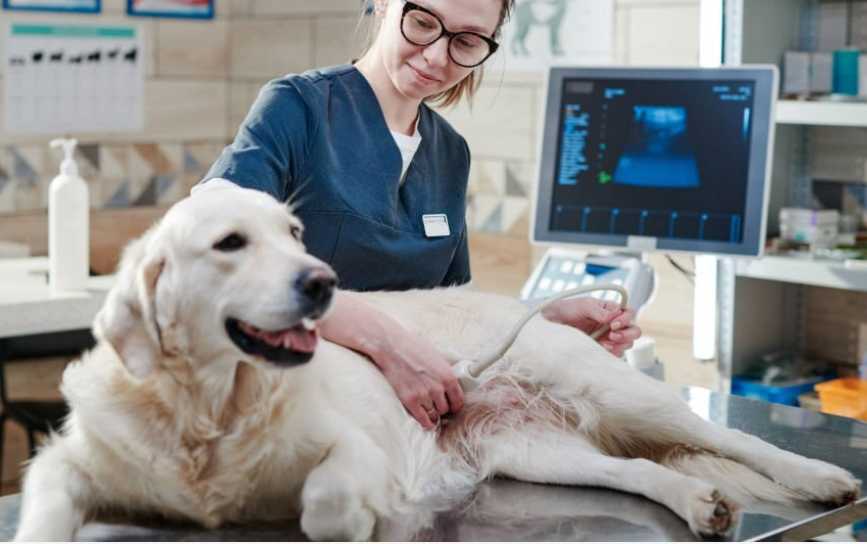
- Owner observation –
Owners noticing changes like bunny-hopping gait, stiffness, limping, or reluctance to exercise prompt the need for a vet exam. Keeping a record of symptoms helps.
- Physical exam –
Vets manipulate the dog’s hind legs to check for signs of looseness, reduced range of motion, pain, or clicking in the hip joints.
- Medical history –
Any prior injuries or lameness and the hip health of parents/siblings provide insight into risk factors.
- Blood tests –
Complete blood count and blood chemistry to check for inflammation.
- Radiographs (X-rays) –
This is the standard definitive diagnostic test. X-rays of the hip joint are taken while the dog is sedated to evaluate joint congruity, signs of arthritis, and severity.
- Additional imaging –
CT, MRI, or ultrasound may examine soft tissue damage closely.
Two main diagnostic tests in the United States are used for hip dysplasia screening.
OFA (Orthopedic Foundation for Animals):
- Radiographs taken when dog is ≥2 years old
- Qualitative method – hips graded as excellent, good, fair, borderline, mild, moderate, severe
- Widely used but low sensitivity in detecting early joint laxity
- Relies on visible arthritis signs, so may miss early dysplasia
PennHIP:
- Radiographs are taken when the dog is 16-20 weeks old
- Quantitative method – calculates “distraction index” using precise measurements
- More accurate for detecting joint looseness before arthritis develops
- Allows for early preventive treatment
- Results not affected by positioning or sedation
The quantitative PennHIP method is considered more sensitive for identifying dogs predisposed to hip dysplasia, especially for high-risk breeds. But OFA is still commonly used. Talking to your vet about the appropriate screening test is essential for early diagnosis and treatment.
Diagnosed and Treatment Process of Dog Hip Dysplasia
After diagnosis, several treatment options for managing hip dysplasia in dogs exist. The most critical factor is early diagnosis and prevention of obesity. A nutritious diet tailored for joint health and moderating activity while young helps dogs stay active and comfortable long-term. Work closely with your vet for an integrated treatment plan.
- Medications – Nonsteroidal anti-inflammatory drugs (NSAIDs) like carprofen are commonly prescribed to relieve pain and inflammation. Other joint supplements may be recommended.
- Injections – Steroid injections directly into the joint or hyaluronic acid injections can help improve joint mobility and reduce pain.
- Physical therapy – Low-impact exercises like swimming, underwater treadmill, passive range of motion, and massage can strengthen muscles and maintain joint health. The College of Veterinary Medicine at Michigan State University researches gait analysis and functional rehabilitation techniques, such as underwater treadmill training.
- Weight management – Keeping dogs lean takes the pressure off joints. A healthy weight is key, but most dogs lose 1%-2% of body weight monthly.
- Surgery – Total hip replacement surgery or procedures like triple pelvic osteotomy can realign hip joints for severe cases.
- Alternative medicine – Acupuncture, cold laser therapy, and therapeutic ultrasound may relieve pain.
The School of Veterinary Medicine at the University of Wisconsin-Madison is researching stem cell therapy as a regenerative treatment option for arthritic joints.
Started Treatment and Surgical Procedures for Canine Hip Dysplasia
There are diverse surgical interventions available to treat hip dysplasia in canines. Non-surgical options, including medication, weight management, therapy, and joint supplements, should be explored first. Surgery is a last resort for severe dysplasia causing immobility and pain.

Other alternatives like “orthopedic braces, acupuncture, massage, and laser therapy” may provide additional relief. Work closely with your veterinarian to determine the best options for your dog’s needs and lifestyle.
Available surgical interventions,
- Juvenile Pubic Symphysiodesis (JPS) – Done in puppies under 20 weeks old to restrict pelvic growth and improve joint fit. Cost: $1,500-$2,000.
- Total Hip Replacement (THR) – The hip socket and head are replaced with prosthetics. For dogs > 1 year old. Cost: $3,000-$5,000.
- Femoral Head Ostectomy (FHO) – The femoral head is removed to stimulate the body to form a false joint. The non-weight-bearing portion is removed. Cost: $2,000-$2,500.
- Double/Triple Pelvic Osteotomy (DPO/TPO) – The pelvis is cut and rotated to improve femoral head coverage. For young dogs with mild hip dysplasia. Cost: $3,500-$4,500.
The University of Missouri Veterinary Health Center is conducting a comparative study of surgical techniques, specifically exploring the differences between triple pelvic osteotomy and total hip replacement. The research aims to provide insights that can help inform clinical decision-making in veterinary care.
Here are some great points about additional non-surgical treatment options for hip dysplasia.
- Massage – Gentle massage of the hip and thigh muscles can increase blood flow, relax muscles, and reduce pain with no significant side effects.
- Acupuncture – Fine, sterile needles are inserted along acupressure points to relieve muscle tension and inflammation. It can boost nerve activity and blood circulation.
- Medical management – Combining medications, joint supplements, physical therapy, weight control, and low-impact exercise recommended by a vet can avoid surgery.
- Orthopedic braces/harnesses – Can shift weight off the rear legs and hips to improve mobility, reduce pain, and provide joint support.
- Cold laser therapy – Low-level light therapy can reduce inflammation and stimulate tissue regeneration with minimal side effects.
- Dietary supplements – Glucosamine, chondroitin, omega-3’s, turmeric, and MSM provide building blocks for joint health.
The takeaway is there are many non-surgical alternatives and complementary treatments to try before considering invasive options. Working closely with your vet for a medical management plan is vital to the best quality of life.
www.puppiesdiary.com
Decrease the risk of Hip Dysplasia
Several effective ways exist to reduce the risk of a dog developing hip dysplasia. Buy from responsible breeders who screen for hip dysplasia. Avoid breeding dogs with poor hip conformation.
Feed a complete and balanced large-breed puppy diet. Avoid overfeeding and rapid growth. Maintain a lean body weight. Obesity stresses joints. The ideal BCS is 4-5/9.
- Moderate, low-impact exercise, and avoid too much high-impact activity before age 18 months when bones/joints are still developing.
- Prevent injury and falls, especially during puppyhood. Don’t allow jumping on/off high surfaces.
- Give joint supplements like glucosamine, chondroitin, and omega-3. Support healthy cartilage.
- Have annual vet exams for early detection. Signs often start between 4-12 months old. Early diagnosis is key.
- Consider PennHIP radiographs starting at 16 weeks for the highest-risk breeds.
“Responsible breeding, proper nutrition, ideal body weight, controlled exercise, and injury prevention” help set up puppies for healthy musculoskeletal development and reduced hip dysplasia risk.
Can dog hip dysplasia be cured?
Doctors cannot cure Dog Hip dysplasia, but the outlook for dogs diagnosed with it is often positive with proper management. Many dogs live comfortably for years when treated early before arthritis sets in. The key is early screening and diagnosis.
Dogs can maintain an active lifestyle with “medication, joint supplements, weight control, exercise regulation, and therapy”. Custom treatment plans are tailored to manage each dog’s symptoms and progression. Mild cases may require less intervention.
Severely affected dogs may eventually need surgery like total hip replacement for pain relief and mobility. Quality of life depends on an owner’s committed care and working closely with their veterinarian. Genetic Diseases and environmental factors mean no two cases are exactly alike. Treatment is adjusted accordingly. With diligent observation and preventive care, dogs can continue to enjoy walks, play, and time with their families.
While there is no cure, hip dysplasia is often highly treatable, especially when detected and addressed early on. Most dogs go on to live happily with some extra management and TLC.
Conclusion
In summary, here are the key takeaways about hip dysplasia in dogs.
It’s a common developmental skeletal disorder, especially in larger breeds. Careful screening and early diagnosis are crucial. Genetics plays a significant role, but environmental factors like diet, exercise, and injury are also risk factors.
Watch for symptoms like bunny-hopping gait, lameness, stiffness, and reluctance to exercise, starting between 4-12 months old. Diagnosis is made through physical exams, medical histories, and radiographic tests like X-rays and the PennHIP method.
Treatments range from medication and joint supplements to surgery for severe cases. Weight management, therapy, and low-impact exercise help too. Prevention focuses on responsible breeding, proper nutrition, ideal body weight, controlled exercise, and injury prevention during development.
While there is no cure, dogs with diligent care and early treatment can live happily with hip dysplasia. We’d love to hear about your experiences managing this condition! Sharing tips helps all pet owners.

![How Can I Treat A Hole In My Dog's Skin? [3 Hidden Tips To Fast Cure] 7 How Can I Treat A Hole In My Dog’s Skin? [3 Hidden Tips To Fast Cure]](https://www.puppiesdiary.com/wp-content/uploads/2023/04/How-Can-I-Treat-A-Hole-In-My-Dogs-Skin-768x456.webp)

